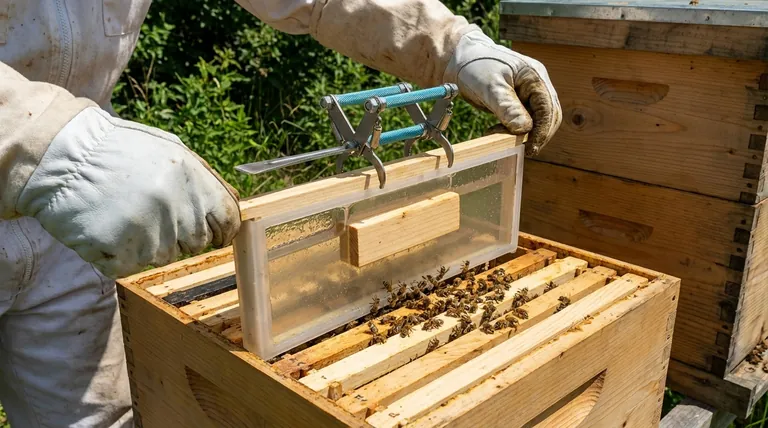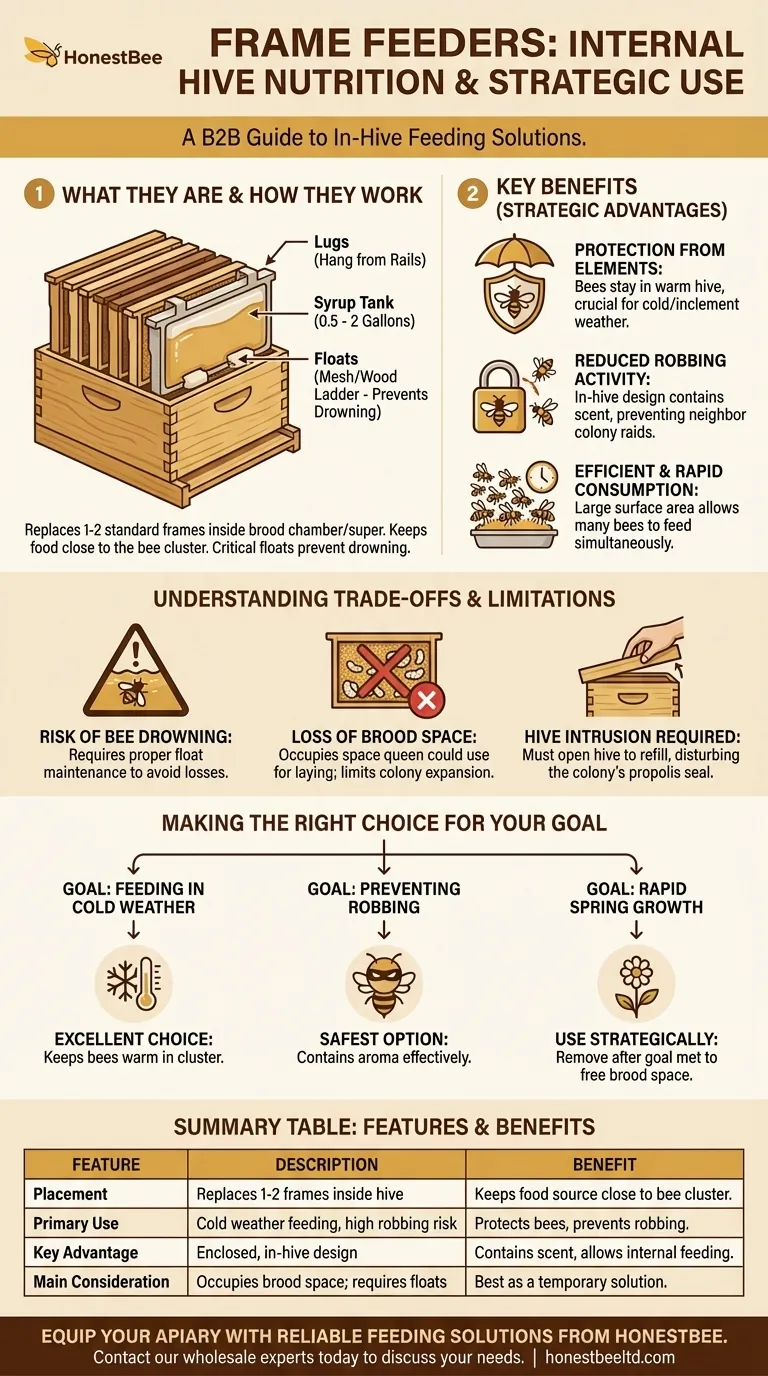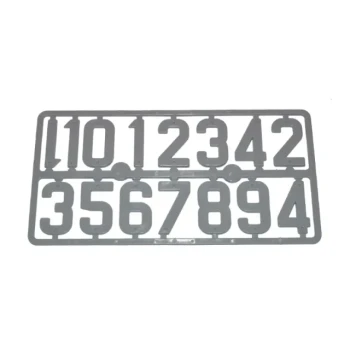A frame feeder is a specialized container that holds liquid sugar syrup and is designed to fit inside a beehive, taking the place of one or two standard frames. This internal placement allows beekeepers to provide supplemental nutrition directly within the hive, minimizing disturbance and protecting the colony from outside elements.
The core value of a frame feeder is its ability to provide a large, protected food source inside the hive. This makes it exceptionally useful for feeding bees during colder weather or when the risk of robbing by other colonies is high, though it comes at the cost of occupying valuable brood-rearing space.

How a Frame Feeder Works
A frame feeder, also known as an in-hive feeder, is a simple yet highly effective tool for bee nutrition. Its design is based on seamlessly integrating with the colony's living space.
Core Design and Placement
The feeder is shaped exactly like a Langstroth frame, complete with top "lugs" that allow it to hang from the hive body's rail.
It is placed directly inside the brood chamber or a honey super, replacing a frame that has been removed. This central location keeps the food source close to the bee cluster.
Capacity and Material
Most frame feeders are made of molded plastic and come in various volumes, typically holding between a half-gallon and two gallons of syrup.
The choice of size depends on the colony's needs and how frequently the beekeeper can refill it.
The Critical Role of Floats
The feeder's open top creates a significant drowning risk for bees. To prevent this, a flotation device is essential.
Many feeders come with a wooden float or a plastic mesh ladder that allows bees to climb down, access the syrup, and climb back out safely.
Some beekeepers also stuff the tank with dried vegetation or other materials to provide a safe landing surface for the bees.
Key Benefits of Using a Frame Feeder
The primary advantages of a frame feeder stem from its enclosed, in-hive design. It offers a strategic solution to several common feeding challenges.
Protection from the Elements
Because the feeder is inside the hive, bees can access food without leaving the warmth and safety of the cluster.
This is a major advantage during early spring, late fall, or any period of inclement weather when foraging is impossible.
Reduced Robbing Activity
External feeders can attract bees from neighboring hives, leading to "robbing," where stronger colonies raid weaker ones for their food stores.
A frame feeder contains the scent of the syrup within the hive, making it far less likely to trigger this destructive behavior.
Efficient and Rapid Consumption
The feeder's design provides a large surface area for the syrup. This allows a great number of bees to feed simultaneously.
This is especially useful when you need to deliver a large volume of feed to a colony quickly to build them up or prepare them for winter.
Understanding the Trade-offs
While effective, frame feeders are not without their downsides. Understanding these limitations is key to using them correctly.
The Risk of Bee Drowning
If the float is not properly installed or becomes dislodged, a significant number of bees can drown in the syrup. This is the most common and serious drawback.
Loss of Brood Space
The feeder takes the place of a frame that the queen could be using to lay eggs or that workers could use to store pollen and honey.
Using a frame feeder for an extended period in a growing colony can limit its expansion, so it is often a temporary solution.
Hive Intrusion is Required
Although less disruptive than some methods, you still must open the hive lid and inner cover to check the syrup level and refill the feeder. This can break the hive's propolis seal and disturb the colony.
Making the Right Choice for Your Goal
Using a frame feeder is a strategic decision based on weather, colony strength, and your management goals.
- If your primary focus is feeding during cold or poor weather: The frame feeder is an excellent choice because it keeps the bees inside the warm hive cluster.
- If your primary focus is preventing robbing from other hives: This feeder's in-hive design contains the syrup's aroma, making it one of the safest options available.
- If your primary focus is rapid population growth in spring: Be mindful that the feeder occupies space the queen needs for laying, so use it strategically and remove it once the goal is met.
Ultimately, the frame feeder is a valuable tool that provides a safe and efficient way to nourish a colony when external conditions are challenging.
Summary Table:
| Feature | Description | Benefit |
|---|---|---|
| Placement | Replaces 1-2 frames inside the brood box/super. | Keeps food source close to the bee cluster. |
| Primary Use | Feeding during cold weather or high robbing risk. | Protects bees from elements and prevents robbing. |
| Key Advantage | Enclosed, in-hive design. | Contains syrup scent and allows feeding without leaving the hive. |
| Main Consideration | Occupies brood space; requires a float to prevent drowning. | Best used as a temporary solution for specific goals. |
Equip your apiary with reliable feeding solutions from HONESTBEE.
As a trusted supplier for commercial apiaries and beekeeping equipment distributors, we understand the critical need for efficient, safe hive management tools. Our high-quality frame feeders are designed to support your colonies' health and productivity, especially during challenging weather or to prevent robbing.
Let us help you strengthen your operation. Contact our wholesale experts today to discuss your needs and explore our full range of beekeeping supplies.
Visual Guide

Related Products
- Professional 3-Bar Frame Grip with Integrated Hive Tool
- HONESTBEE Advanced Ergonomic Stainless Steel Hive Tool for Beekeeping
- Professional Dual-End Stainless Steel Hive Tool for Beekeeping
- Beehive Handle and Frame Rest Cutting Machine: Your Specialized Hive Machine
- Manual Spur Wheel Wire Embedder for Foundation
People Also Ask
- What is required to be a beekeeper? Essential Equipment, Knowledge & Mindset
- How should Frame Grips be maintained after use? A Guide to Biosecurity and Tool Longevity
- What parts of bee equipment should be painted? A Guide to Protecting Your Hive and Your Bees
- What products pair well with Frame Grips for beekeeping? Build Your Complete Hive Inspection Toolkit
- Why is proper beekeeping equipment important? Essential for Safety and Hive Health



















